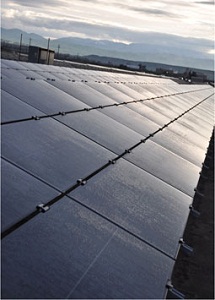MiaSolé gets Ex-Im Bank support for its first project in India
 The U.S. Export-Import Bank of the U.S. is supporting a 2-megawatt project using MiaSolé’s thin-film photovoltaics ins Gujarat, India.
The U.S. Export-Import Bank of the U.S. is supporting a 2-megawatt project using MiaSolé’s thin-film photovoltaics ins Gujarat, India.
The bank is offering Texas-based project developer Universal Solar System a $3.7 million, 10-year loan with a fixed 3.8 percent interest rate to support the project, which uses modules made by MiaSolé in California.
It’s the first time that MiaSolé has had a solar project in India, and the first time it’s had a project supported by the Ex-Im bank.
“We’ve got many projects in Europe that have standard Europe bank [financing]. This is the first we were able to do low-cost financing through Ex-Im bank,” said Rob DeLine, MiaSolé vice president of marketing.
The company, which makes thin-film copper indium gallium selenide (CIGS) photovoltaics, is one of a growing number of U.S. solar manufacturers with projects in India supported by Ex-Im Bank.
The company may also look to Ex-Im bank to help with future solar projects.
“We have a pipeline of projects that include India, Eastern Europe and maybe Southeast Asia,” DeLine said.
In such countries with a national solar policy and enough of a local industry, MiaSolé may pursue financing with Ex-Im.
“Our business model is to follow the solar industry at large,” DeLine said. “In that space 90 percent of the industry is outside of the U.S. We initially focused on Western Europe. Over the last six months we broadened that to India and Eastern Europe.”
In 2012 the company could also look at developing projects in one to two more countries, including in South America.
The company has been ramping up production on its modules in preparation for more projects in 2012. In early 2012, the company will complete work on its first fabrication plant, which has an annual production capacity of 150 megawatts.
It’s far less than cadmium telluride (CadTel) producer First Solar, which is on track to produce 2.3 gigawatts of modules in 2011, but enough for the company to be more flexible and selective in the projects it undertakes, according to DeLine.
“At this point being small in 2012 it has its advantages,” he said.
The company also is still boosting up the efficiency of it modules. It began in 2011 at about 10 percent efficiency and will ship modules in the first half of 2012 that are 14 percent efficient, according to DeLine.
In the second half of the year, it’s modules could reach 15 percent efficiency.
“[MiaSolé is trying] to provide crystalline silicon performance with material that reduces cost,” he said.
It’s also looking into manufacturing flexible photovoltaics that could be integrated into buildings.
“That product would be a 14 percent efficient flexible product,” DeLine said.
MiaSolé plans to pilot such a product in 2012 and expand production in 2013, opening it to other, younger solar markets.



